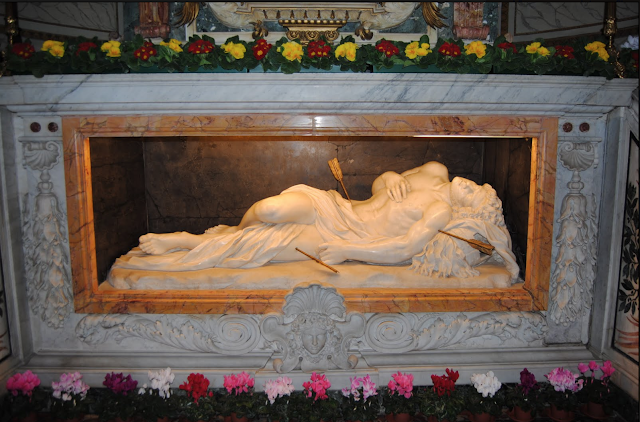Nicolas Regnier, 17th century
Yesterday was the Feast of Saint Sebastian, the Church's favorite naked altar boy, an object of centuries worth of repressed homoerotic desire.
According to tradition, he was a soldier in the Praetorian Guard under the Emperor Diocletian. Diocletian brought the Third Century Crisis to an end by tying together the tattered fragments of the Roman Empire into an Imperial cult centered around the divine Emperor, himself. That cult tolerated no competition or dissension. The Emperor undertook the most thorough and ruthless of all purges of the illegal Christian religion. He was determined to destroy it root and branch. Sebastian understandably kept his faith quiet until he was found out. The Emperor ordered Sebastian tied to a tree and shot full of arrows until he died. Saint Irene went to claim the body, and discovered that he was still alive. She took him home and nursed him back to health. Miraculously recovered, Sebastian confronted the Emperor and demanded that he stop the suppression of Christians. Emperor Diocletian, astonished at the audacity of someone who was supposed to be dead, ordered Sebastian to be beaten to death on the spot and his body thrown into a sewer.
I'm not quite sure how this particular Roman soldier saint (among many) became an object of thinly veiled homoerotic longing as early as the 15th century throughout Europe. But, he was and still is, though now those desires are no longer suppressed but quite open. He certainly appears as a suffering object of desire in so much of the art about him. He's always young, athletic, and beautiful no matter how many arrows are sticking in him. Sometimes the most institution-bound traditional images of Sebastian are the most androgynous (see the prayer card below). Certainly Sebastian's youth and beauty in art played a role in his enduring popularity down through time. If anything, those qualities enhanced the poignancy of his suffering for many people. For gay male Christians over many centuries, he became a suffering lover of Christ.
The earliest work of art showing Sebastian that I was able to find is this 7th century mosaic in San Pietro in Vincoli in Rome.
I'm not quite sure when he became a young man deprived of his clothes and tied to a tree, but it seems to be sometime around the end of the 14th and the beginning of the 15th centuries.
From the early Renaissance onward Sebastian becomes a frequent subject of art. The homoeroticism is there from the beginning and becomes more so down to the present day. All that same sex desire that might have been projected onto the suffering Christ deflected onto a martyr of similar age who also died a painful death.
15th century German altarpiece from Cologne
Josse Lieferinxe, Altarpiece of Saint Sebastian, 15th century
Josse Lieferinxe, Saint Irene Tending St. Sebastian, from the St. Sebastian Altarpiece
Hans Memling, 15th century
Josse Lieferinxe 15th century. St. Sebastian was a plague saint. Since at least the Black Death, people always prayed to Sebastian in times of plague. They probably prayed to him because the painful skin lesions that frequently accompanied the disease felt like wounds from arrows.
Pollaiuolo, 15th century
Piero della Francesco, from the Misericordia Altarpiece, with St. John the Baptist, 15th century
Andrea Mantegna, 15th century
Andrea Mantegna, 15th century
Antonello da Messina, 15th century; a personal favorite of mine.
Giovanni Bellini, from the San Giobbe Altarpiece, 15th century; St. Sebastian was very popular in plague vulnerable Venice.
Titian, 16th century; Saint Mark in shadow with Saints Cosmas and Damian, Roch, and Sebastian, all plague saints. The Venetian Senate commissioned the picture as an ex voto for deliverance from an outbreak of plague in 1510. The artist Giorgione, a friend and mentor to Titian, died in this plague.
Titian, 16th century
Bronzino, 16th century; perhaps a young Florentine nobleman portrayed as the saint.
El Greco, 16th century
Annibale Carracci, 17th century
Ludovico Carracci (Annibale's cousin) 17th century; one of the few depictions of Sebastian dumped in the sewer.
Orazio Gentilleschi (Artemisia's father), 17th century
George De La Tour, 17th century
Hendrik Terbrugghen, 17th century
Jusepe de Ribera, 17th century
Guido Reni, 17th century; a favorite painting of Oscar Wilde
Rubens, 17th century
Mattia Preti, 17th century
Nicolas Regnier, 17th century
Francois Xavier Fabre, 19th century
Paul Delaroche, 19th century
Gustave Moreau, 19th century
Yukio Mishima, 20th century
Derek Jarman, 20th century
Pierre et Gilles, 20th century
Prayer card, 20th century
The Basilica of Saint Sebastian, Rome
In 1988, I visited the Basilica of St. Sebastian in Rome along with the catacombs underneath it. According to tradition, Saint Sebastian was buried here in 350 CE.
No, these photos are not mine.
This is the reliquary shrine of Saint Sebastian in the church. What remains of him rests under a swooning homoerotic 17th century sculpture by Antonio Giorgetti.
The catacombs under the church.
EXTRA:
Saint Sebastian today takes on a whole new life as a patron saint of gay men and as a plague saint in the time of AIDS. Above is a painting by Tony de Carlo (1956 -2014), one of many he made of the saint as a gay man and as an object of same sex desire, and as a plague saint. Kittredge Cherry made a fine survey of some contemporary gay artists' visions of the saint.
Included is this beautiful prayer by the artist Tony O'Connell:
“St. Sebastian, who strengthens the persecuted Pray for us…
St. Sebastian empowered to protect from plague and AIDS, Pray for us…
St Sebastian, loved and then abandoned by the Roman Emperor, Pray for us.
St. Sebastian, loved and increasingly abandoned by the Roman Church, Pray for us
St. Sebastian, Loved by our people, Pray for us…
Glorious Martyr and undefeated warrior,
we ask that you protect the persecuted from tyrants and enemies.
Use your unstoppable energy
not to punish but only to humble
those who dedicate themselves to oppression and evil.”







































